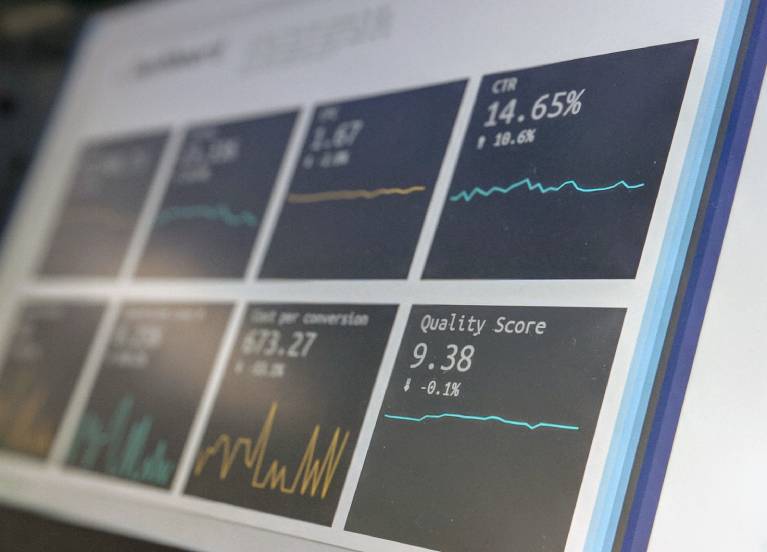Back in 2011, Google produced this wonderful advert hailing the benefits of Google Analytics. ‘Find out where your customers are checking out’, it promised.
The ad is completely accurate of course: Analytics is a powerful tool for tracking client behaviour and ultimately reporting on your success and ROI.
However…
It’s a little ironic that the feelings of frustration shown by the character in the advert mirror the frustration felt by many marketers when it comes to getting exactly the data they need out of Analytics.
We’ve all been there, bleary-eyed and ready to launch a laptop through the window when Analytics pulls a ‘computer said no’ moment at the time you needed an exact figure the most.
And that’s because, though Analytics is a great tool in the right hands, it’s also both a very complicated one and just one of the available ways you can report on your marketing campaign effectiveness. And that’s particularly true when it comes to inbound marketing…
Why inbound marketing allows for better reporting on campaign success and ROI
Online user journeys are more complicated than ever. Yet when you launch an inbound marketing campaign you create a series of short trackable mini-journeys that should help you to judge whether your inbound marketing campaign has been a success or not.
Think of it this way. Judging whether you’ve had a successful last decade as a person is a complicated assessment, should you wish to undertake it. You probably need the equivalent of an enterprise level Google Analytics setup to assess whether you made the right choices here, chose the right routes there and ended up a better person than when you started (whatever that means!).
But judging whether you had a successful trip to the shops yesterday is much easier. It was a short linear journey with an easy-to-identify goal. Did you get home with the shopping you wanted or not?
Inbound marketing creates these small pockets to help you to judge the effectiveness of your marketing activities. Within each you see the success of your ‘mini journey’. Taken together you see whether you’re achieving digital marketing success overall.
Oh and… we like inbound marketing, but we’re not ready to claim just yet that it makes you a better person. Although, maybe…
Using SMART as a model for measuring the effectiveness of a marketing campaign
Before looking at some of the journeys your users might take through your inbound marketing and how you can measure them, it’s worth thinking about what you want to achieve at the end of this. To that end the SMART system of setting goals and targets is incredibly useful.
A SMART goal is:
- Specific – The goal is defined and exact, rather than generalised and open to interpretation.
- Measurable – We will clearly know if we’ve hit the goal or missed it.
- Achievable – We can do things to help us to hit our goal.
- Realistic – There’s a good chance of success. We’re not shooting for Amazon’s page visit number here.
- Timely – We’re aiming to achieve this goal within a specific period.
A really great example of a SMART goal
“We’re launching a new piece of gated content and we want to achieve 60 downloads in the first month. We know we have a reasonable advertising budget to work with to help us.”
Specific – We want to look at downloads and only downloads.
Measurable – In fact we want 60 or more downloads!
Achievable – We’ve got that advertising budget to help us.
Realistic – That depends on unknown factors in our example, but 60 feels a reasonable number.
Timely – We’ve given ourselves a month.
Consider the journeys your users take through your inbound marketing
Back to our mini-journeys…
Consider the inbound model of attract, convert, close and delight. That model is set up to create miniature journeys, because your users are naturally going to move between those stages. Within each stage is a smaller journey with specific content marketing metrics that you can use to measure the success of that stage of your campaign.
Measuring success – attract
Attract is all about getting people to your website, so traditional digital marketing metrics are very much in play here. Overall visits and unique sessions increasing are signs of a successful attract strategy. If you monitor your position in the SERPs (Search Engine Results Pages) for certain keywords then these should also be heading in a positive direction.
You’ll also need to think about other ways you’re creating user journeys into your website. Are you running advertising campaigns? Engaging in outreach or influencer marketing? These all need to be monitored individually to judge the success of the tactic.
Measuring success – convert
The convert ‘mini journey’ sees people who are already on visitors to your website turning into leads. To do that they’ll be submitting a form on your website of some sort. This could be to register for a webinar or maybe to download a piece of content or even just filling in an enquiry form.
You can measure your convert success by looking at the conversion rate of your landing pages. How many visitors do they attract and what percentage of visitors become leads?
You can also look more closely (particularly if you use HubSpot) at elements such as the success of your CTAs. If one of your blogs sends more people to a landing page than others, does it have a different CTA? Look at the CTR (Click Through Rate) of individual CTAs to judge which are successful.
Measuring success – the journey between convert and close
You can measure the success of your inbound marketing at another point by introducing Marketing Qualified Lead (MQL) and Sales Qualified Lead (SQL) definitions. If you’re yet to do this then there’s a full guide on how to build a digital marketing sales funnel here.
Essential MQLs and SQLs allow you further reporting steps to assist you in judging how good your leads are. Is the problem that your marketing is not generating enough leads of the right type or that your sales efforts are not closing the right leads. Look at the conversion rate between MQL and SQL to start your reporting journey here.
Measuring success – close
The close stage of a customer journey is normally handled by sales, but marketing still has a part to play and there are still ways to measure your success.
What materials do sales have to assist them in closing deals? Any documents you provide for sales to use, such as case studies, can be tracked. Do prospects open and read them? What are the open rates? Can you improve them with providing your salespeople with a templated email?
Throughout all of these mini journeys you should measure the percentage of leads who progress through each stage. Measuring the conversion rate from convert to close is particularly important. What percentage of leads that you pass to sales end up being clients?
Measuring success – delight
Customer sentiment is most commonly tracked through Net Promoter Score (NPS). Customers are asked how likely they are to refer you to family and friends, on a scale of 1-10. An average rating of above 9 is considered a strong score.
Ultimately though, you can measure customer satisfaction through your bottom line and ROI figures.
The ultimate goal: looking at ROI
At some point you will need to look at how to measure your marketing ROI. There are various calculations you can use for this, with the below being a common starting point.
(Revenue — Investment) / Investment = Y
Y x 100 = ROI%
In real terms then, let’s say you have a marketing budget of £60,000 per year and you generate turnover of £1 million. Not bad figures for an SME.
(1,000,000 – 60,000) / 60,000 = 15.7
15.7 x 100 = 1,570% ROI
Brilliant! A fantastic ROI figure.
You can use the same calculation to determine your ROI per channel. If you’ve spent £10,000 on Google Adwords, that’s your investment. You’ll now need to look at which customers came from that source, and how much they spent, to calculate what ROI you got from your AdWords spend.
HubSpot hint: HubSpot does the above for you automatically, by tracking your ad spend within the platform, tracking which contacts are created from advertising and then tracking through to which contacts end up with the lifecycle stage of ‘customer’.
How to create marketing reports that show off your success
Now that you’ve got all of your data together it’s important to show off your inbound marketing campaign success and ROI performance!
Whilst by this point you’ve probably conquered Excel, mastered HubSpot’s reporting and even got to the bottom of Google Analytics, it’s likely that the management team of your company aren’t quite as au fait with the tools you use.
We’ve got a whole page dedicated to guiding you through how to create digital marketing reports your boss will love, but here are some basic principles to follow.
- Report on the metrics management care about. This often means looking at ROI, particularly if you’ve just run a significant campaign.
- Google Data Studio is a useful tool to visualise data in a user-friendly way.
- If your target audience like paper and PDFs then use paper and PDFs. If they’re Powerpoint or Slides people then use Powerpoint or Slides. Don’t force your audience to learn a new medium whilst showing them new data unless you absolutely have to.
Go forth and measure your success!
All marketing is ultimately experimentation to some degree and all experiments need measuring.
Inbound campaigns in particular lend themselves to hyper-focused measurement of individual mini-journeys your target audience go on every day.
Using that information you can build up a picture of individual and overall success and get to an overall ROI figure that delights your management team.
Go forth and measure! If you need any help with doing that then you can get in touch with us here. Good luck!
Next Post



